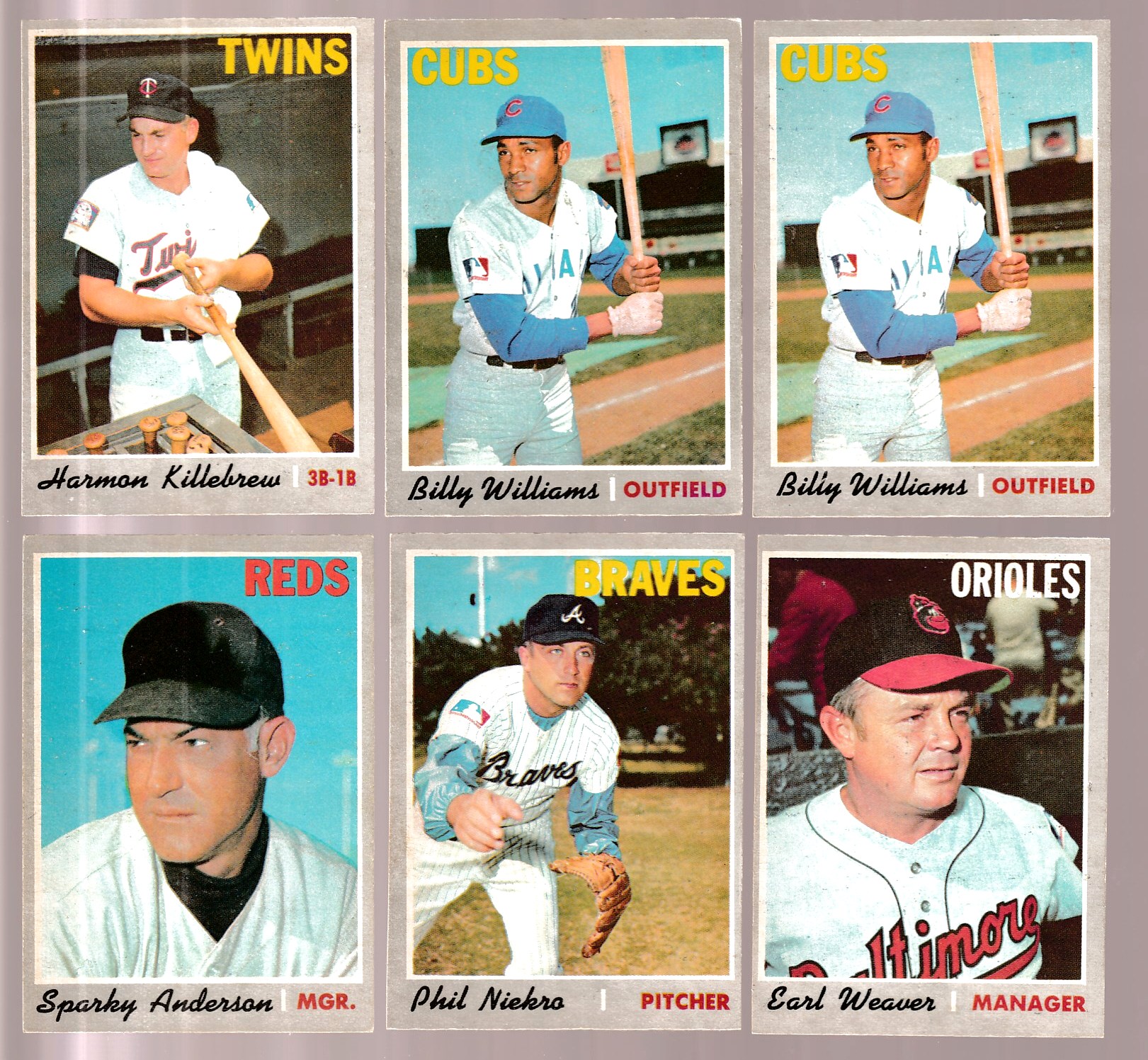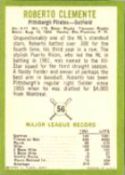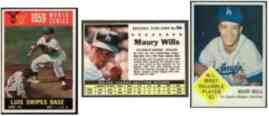1970 O-Pee-Chee/OPC #170 Billy Williams (Cubs)
| Grade |
EX/MINT |
| Book Value |
n/a |
| Our Price |
$ 14.95
Add to cart
|


Below are short bits & pieces on sportscard & baseball trading card collecting.
Please wander around the website for more info, prices, values & images
on vintage baseball, football, basketball, hockey, sport and non-sports cards.


1963 Fleer Baseball Cards
Checklist & Values
1960 & 1961 Fleer baseball card sets of old-timers
like Babe Ruth bombed. Kids wanted Willie Mays & Mickey Mantle.
Topps had rights to baseball cards & gum so Fleer
tried something new ... COOKIES !!!
Cherry flavored cookies with 1963 baseball cards.

1963 Fleer baseball card set was cut short at 66 cards & checklist
by Topps lawsuit. But what 66 cards! Attractive & packed:
Clemente,Koufax... & 2 very scare Short Prints.

Maury Wills 'rookie' card is a story.
Majors in 1959, quickly superstar. But 1963 for rookie ???
In 1959 Topps deemed Wills NOT WORTHY.

 Wills was upset. After 1962 MVP, Topps came knocking but he said "NO!".
Finally, 1967, Wills first Topps & most costly card.
Note: 1961 Post Cereal card, years BEFORE
Wills was upset. After 1962 MVP, Topps came knocking but he said "NO!".
Finally, 1967, Wills first Topps & most costly card.
Note: 1961 Post Cereal card, years BEFORE
 'official' rookie. He also photo-bombed a 1960 Topps card.
'official' rookie. He also photo-bombed a 1960 Topps card.
Disclaimer: Above mostly true - but Wills has said "no feud".
Note: You may be on that page right now.
|

1976 Popsicle Football Teams
Cards checklist
There is one card for each NFL team in the 1976 Popsicle football
card set PLUS a variation of the New York Giants.
The Giants changed logos in 1976, but Popsicle didn't know
so one card shows team's 1975 helmet and the corrected
shows the 1976 helmet.
The cards are like thin plastic credit cards and held up well
as apparently they came one per box of Popsicles.
Note: You may be on that page now.
|

1948-1949 Leaf Baseball Cards
Checklist & Values



... Babe Ruth ... Joe DiMaggio ... Honus Wagner ... Jackie Robinson ...
... Ted Williams ... Stan Musial ... Satchel Paige ... Warren Spahn ...
Man was the 1948-1949 Leaf baseball set PACKED !!!
The set was small in numbers and size with only (98) 2-3/8" by 2-7/8"
cards. With only 98 cards, the set was "skip-numbered" with card numbers
from 1 thru 168. Likely an attempt to force collectors to keep buying packs
looking for their missing cards. (49) cards are considered "Short Prints"
and there is one variation card #136: Full Sleeve/Short Sleeve (error)
Note: You may be on that page right now.
|

Baseball card collecting terms (part A)
Airbrushing is the art of touching up a photo prior to the card being printed.
It was generally done to remove imperfections or update or hide a players
jersey/cap logo. Because of advancements in print technology and computers this is
no longer needed.
All-Star card (AS) usually a subset card picturing a player who participated in the
previous seasonís all-star game. Topps created these in their 1958 High Number
issue and has continued the practice fairly regularly to date. Such cards
are usually designated in price guides with the abbreviation of AS.
Assorted A general mix of cards often containing many duplicates.
Auction items are sold to the highest bidder. Auctions used to be live
or thru the mail/phone but today most auctions are online.
Auction Catalog lists the rules and descriptions and often images
of the items in an auction.
Authentication verification that an item (card, autograph) is genuine. Most "game-used"
material inserts have a written declaration of authenticity on the reverse.
Authorized Issue card or memorabilia item that has been properly licensed. If
the item is of a player, his written permission must be given in order for it to be considered authorized.







 1963 Fleer baseball card set was cut short at 66 cards & checklist
by Topps lawsuit. But what 66 cards! Attractive & packed:
Clemente,Koufax... & 2 very scare Short Prints.
1963 Fleer baseball card set was cut short at 66 cards & checklist
by Topps lawsuit. But what 66 cards! Attractive & packed:
Clemente,Koufax... & 2 very scare Short Prints.  Maury Wills 'rookie' card is a story.
Majors in 1959, quickly superstar. But 1963 for rookie ???
In 1959 Topps deemed Wills NOT WORTHY.
Maury Wills 'rookie' card is a story.
Majors in 1959, quickly superstar. But 1963 for rookie ???
In 1959 Topps deemed Wills NOT WORTHY. 
 Wills was upset. After 1962 MVP, Topps came knocking but he said "NO!".
Finally, 1967, Wills first Topps & most costly card.
Note: 1961 Post Cereal card, years BEFORE
Wills was upset. After 1962 MVP, Topps came knocking but he said "NO!".
Finally, 1967, Wills first Topps & most costly card.
Note: 1961 Post Cereal card, years BEFORE
 'official' rookie. He also photo-bombed a 1960 Topps card.
'official' rookie. He also photo-bombed a 1960 Topps card. 


